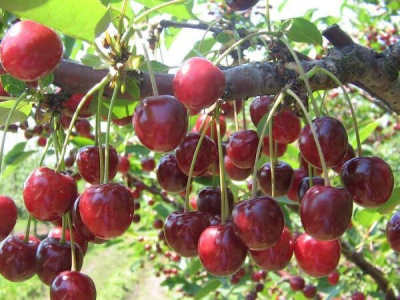
- Authors: Enikeev Kh.K., Satarova S.N., Simonov V.S., Evstratov A.I., Mikheev A.M.
- Year of approval: 2001
- Barrel type: wood
- Growth type: medium-sized
- Crown: spherical, drooping, medium density
- Escapes: straight, brownish brown
- Leaves: large, obovate, dark green, with a large serrate edge
- Flowering and fruiting type: mixed
- Fruit size: large
- Fruit shape: wide, heart-shaped
Cherry Pamyat Yenikeeva is not too old, but at the same time it is already a well-tested variety. Growing it is not difficult. However, you should carefully study the features of the plant.
Breeding history
The culture has been approved for use since 2001. The project was supervised by agronomists Kh.K. Enikeev, V.S. Simonov, S.N. Satarova, A.M. Mikheev, A.I. Evstratov.The application was submitted back in 1995. The applicant was the Federal Research Center for Horticulture.
Description of the variety
Universal cherry Pamyat Yenikeeva belongs to varieties of early ripening. It is a medium-sized tree with a spherical drooping moderately dense crown. Straight-growing shoots are colored brownish-brown. The large leaves are in the shape of an inverted egg and have an unusual edge shape.
The petioles are of medium length. Rich colors are typical for them. The flower cup is visually close to the glass. The petals are slightly corrugated. It is possible to expect the appearance of fruits mainly on bouquet branches.
Fruit characteristics
Cherry fruits in Memory of Yenikeev:
- reach a large value;
- have a uniform size;
- painted in dark red tone;
- weigh on average 4.7 g;
- include 16.3% solids;
- contain 10% sugar;
- include 1.4% acids;
- have an ascorbic acid concentration of 13 ppm.
Taste qualities
The dark red flesh of this variety is very juicy. It tastes sweet. The acidic component is present, but rather pleasant. Tasting score - 4.8 points.
Ripening and fruiting
This plant is early-growing. The first berries can be harvested as early as 4 years of development. They are usually filmed at the end of June. Weather conditions can have a pretty strong effect on the result achieved. Importantly, the harvest ripens at the same time. This property is very nice commercially.

Yield
According to the data from the suppliers of the planting material, during the tests for 1995-2000 the productivity averaged 46.4 centners per hectare. It is very important to emphasize the relevance of proper care. The usual yield of 1 tree is 8-10 kg. At the same time, the maximum recorded level is from 12 to 15 kg.
Growing regions
Cherry is zoned in the Central region (3rd climatic zone). In the southern regions, this crop can also be grown, but there is a serious danger of drying out.
Self-fertility and the need for pollinators
Cherry Pamyat Yenikeeva can be cultivated without additional pollination. To increase biological productivity, it is worth using varieties:
- Belarusian griot;
- Lyubskaya;
- Surprise.
Landing
The most preferable planting of cherries in the spring. There should be a distance of 3 m between individual plants.It is advisable to choose a neutral ground. Soil acidification is handled with lime, wood ash or dolomite ground into flour. All this is brought in during digging.
The sun exposure should be quite high. Decent heating of the site is very important. It is unacceptable to choose places with a high level of soil water. Protection from northerly winds must be provided, especially in winter.


Growing and care
On sandy soils, fertilizer should be applied annually. When landing in a hole, you should make:
- humus;
- potassium chloride;
- superphosphate.
0.015 kg of ammonium nitrate or 0.03 kg of superphosphate is used per 1 m 2. In difficult cases, the concentration is increased to 0.02 and 0.04 kg, respectively. Lime is laid in the ground every 5–6 years. Use of 4–5 pollinator species is preferred to ensure cross-pollination. The root shoots are cut as close to the ground as possible.


Disease and pest resistance
Relatively high resistance to coccomycosis is declared. Resistance to fungal infections is also quite decent. Resistance to moniliosis is assessed as good. It should be borne in mind that in wet seasons, the defeat of coccomycosis increases significantly.
Requirements for soil and climatic conditions
The resistance of this variety to winter conditions is quite high. Heat resistance is low. Therefore, you will have to water the plants very carefully. When grown in the south, such a moment is especially relevant.
































































